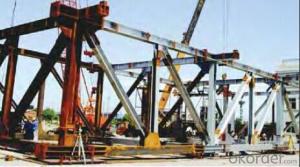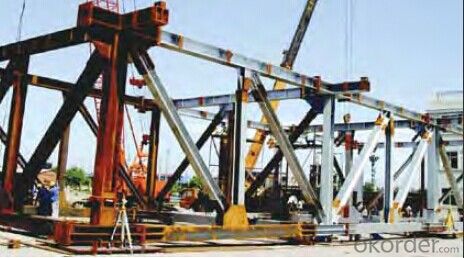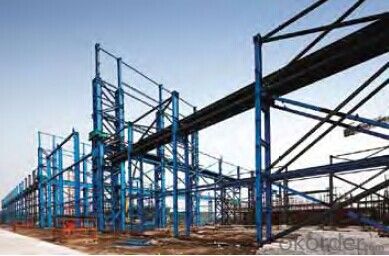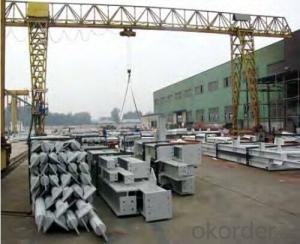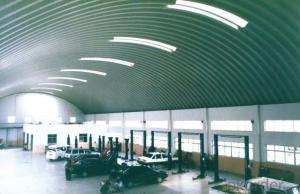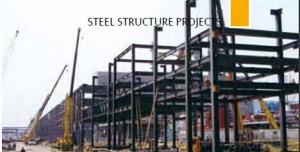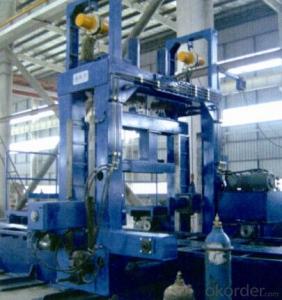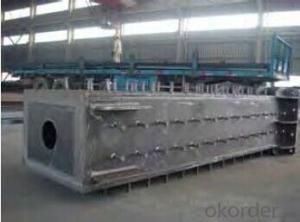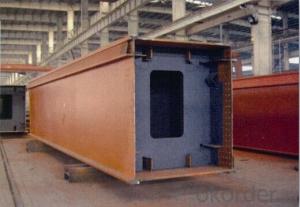High-end Steel Work made in China
- Loading Port:
- China Main Port
- Payment Terms:
- TT OR LC
- Min Order Qty:
- -
- Supply Capability:
- -
OKorder Service Pledge
OKorder Financial Service
You Might Also Like
Steel Structure
Description:
1.Length of the welding withnot indication, full welding should be applied
2.Seam without indication is fillet weld, height is 0.75t
3.The cutting angle without indication, radius R=30
4.Cutting angle not specified should be
5.The diameter of the hole for the bolt if not specified, D=22

Project Reference:
Area: 17,000m2
Steel Structure Quantity: 2,700ton
Color-Steel Plate Area: 29,670ton
Column Height: 32m
Weight of Per Column: 25ton
Crane Tonnage: 300ton
Total Cost: 25,080,000RMB
Duration: 150days

- Q: How are steel railway bridges constructed?
- Steel railway bridges are constructed using a combination of design, fabrication, and construction processes. The initial step involves designing the bridge based on factors like load requirements, span length, and environmental conditions. Fabrication of the steel components then takes place in a controlled environment, where the steel is cut, shaped, and welded together to form the bridge elements. Finally, the bridge is erected at the construction site, using cranes and other equipment to assemble and secure the steel components into their final positions.
- Q: How are steel doors manufactured and installed?
- Steel doors are manufactured through a process that involves shaping and molding steel sheets into the desired door design. This is often done using specialized machinery and techniques such as cutting, bending, welding, and painting. Once the manufacturing process is complete, steel doors are then installed by fitting them into door frames using hinges, locks, and other necessary hardware. Professional installation ensures proper alignment, security, and functionality of steel doors.
- Q: What is the fire-resistant time of steel column under steel structure?
- Steel is a building material that does not burn. It has the characteristics of shock resistance and bending resistance. In practical application, steel can increase the load capacity building relative, can also meet the needs of architectural design modeling, but also to avoid the defects of concrete building materials cannot bend, stretch, so the steel construction industry has been favored, monolayer, multilayer, skyscrapers, factories, warehouses, waiting rooms, lounges etc. the steel is very common. However, as a construction material, steel has some unavoidable defects in fireproofing, and its mechanical properties, such as yield point, tensile strength and elastic modulus, all decrease sharply due to the increase of temperature.
- Q: What are the factors influencing the choice between steel and concrete structures?
- The factors influencing the choice between steel and concrete structures include cost, design flexibility, construction speed, durability, sustainability, and aesthetic preferences.
- Q: How are steel fencing and barriers installed?
- Steel fencing and barriers are typically installed by following a few key steps. First, the area where the fencing or barriers will be installed is measured and marked. Then, the necessary holes or foundations are prepared to securely anchor the steel posts or panels. Next, the posts or panels are carefully positioned and secured into place, often using concrete or specialized brackets. Finally, any additional components like gates or locks are installed to complete the steel fencing or barrier system.
- Q: How are steel structures designed for recreational facilities such as sports stadiums and theme parks?
- Steel structures for recreational facilities such as sports stadiums and theme parks are designed using a combination of engineering principles, architectural requirements, and specific project needs. The design process begins with a thorough analysis of the site conditions, load requirements, and intended usage of the facility. Engineers then create a structural design that utilizes steel as the primary material due to its strength, durability, and versatility. Advanced computer modeling and simulation tools are employed to ensure the structural integrity and safety of the steel framework. Additionally, considerations are made for factors such as aesthetics, accessibility, functionality, and integration with other building systems. The design process involves collaboration among architects, engineers, and other professionals to create efficient, safe, and visually appealing steel structures for recreational facilities.
- Q: What is steel structure?
- Steel structure refers to a construction method that utilizes steel beams, columns, and other components to create a stable and durable framework for buildings and other structures. It is known for its strength, versatility, and ability to withstand various environmental conditions, making it a popular choice in modern construction projects.
- Q: What are the design considerations for steel staircases?
- Design considerations for steel staircases include structural integrity, functionality, aesthetics, safety, and ease of installation and maintenance. Firstly, steel staircases must be structurally sound to support the weight of users and withstand the loads that will be placed on them. The design must account for factors such as the number of users, the intended use of the staircase, and the expected loads. Steel is a strong material, and the design should optimize the use of steel to achieve the desired strength and stability. Functionality is another important consideration. The design should take into account the purpose of the staircase, such as whether it is for residential, commercial, or industrial use. The dimensions and layout of the staircase should be designed to provide a comfortable and efficient means of vertical circulation. Factors such as the rise and run of each step, the width of the staircase, and the handrail design should all be carefully considered to ensure ease of use. Aesthetics also play a significant role in the design of steel staircases. The staircase should complement the surrounding architecture and interior design, enhancing the overall aesthetics of the space. The choice of materials, finishes, and details should be carefully selected to create a visually appealing staircase. Safety is of utmost importance when designing steel staircases. The design should meet or exceed local building codes and regulations to ensure the safety of users. Factors such as slip resistance, sufficient lighting, and appropriate handrail height and design should be considered. It is also important to consider accessibility requirements, such as providing options for individuals with mobility challenges. Ease of installation and maintenance are also important considerations. The design should be practical and easy to construct, minimizing the time and effort required for installation. Additionally, the materials and finishes used should be durable and easy to clean and maintain, minimizing the need for frequent repairs or replacements. In conclusion, when designing steel staircases, it is important to consider structural integrity, functionality, aesthetics, safety, and ease of installation and maintenance. A well-designed steel staircase can provide a durable, functional, and visually appealing solution for vertical circulation in various settings.
- Q: What is the role of steel in cultural and recreational buildings?
- Steel plays a crucial role in cultural and recreational buildings, serving both functional and aesthetic purposes. Firstly, steel is widely used in the construction of these buildings due to its high strength-to-weight ratio. This property allows architects and engineers to design large, open spaces, such as auditoriums, exhibition halls, or sports arenas, without the need for excessive columns or support structures. Steel's ability to span long distances helps create expansive interiors, providing flexibility in layout and accommodating various activities or exhibits. Additionally, steel's flexibility allows for unique architectural designs and iconic structures that become cultural landmarks. From the Eiffel Tower to the Sydney Opera House, steel has been instrumental in shaping the character and identity of cultural buildings around the world. Its malleability enables the creation of intricate and imaginative shapes, making it a favored material for creating visually striking and memorable structures. Moreover, steel's durability and resistance to fire, earthquakes, and other natural disasters ensure the safety and long-term sustainability of cultural and recreational buildings. This is particularly important as these buildings often host large crowds and house valuable cultural artifacts or equipment. Furthermore, steel's recyclability and sustainability make it an environmentally friendly choice for construction. The ability to recycle steel reduces the need for raw materials and minimizes the carbon footprint associated with the construction industry. In summary, steel's strength, versatility, and aesthetic appeal make it an indispensable material in cultural and recreational buildings. Its use allows for the construction of large, open spaces, iconic designs, and safe and sustainable structures that contribute to the cultural and recreational experiences of individuals and communities.
- Q: How are steel mezzanine floors designed and installed?
- Steel mezzanine floors are designed and installed by following a systematic process. First, the design of the floor takes into account factors such as load capacity, layout, and any specific requirements. This is usually done by professionals who ensure compliance with building codes and regulations. Once the design is finalized, the steel components are manufactured and prepared for installation. The installation process involves assembling the steel framework, securing it to the existing structure, and adding the flooring material. The entire process requires expertise and precision to ensure a safe and durable mezzanine floor.
Send your message to us
High-end Steel Work made in China
- Loading Port:
- China Main Port
- Payment Terms:
- TT OR LC
- Min Order Qty:
- -
- Supply Capability:
- -
OKorder Service Pledge
OKorder Financial Service
Similar products
Hot products
Hot Searches
Related keywords
